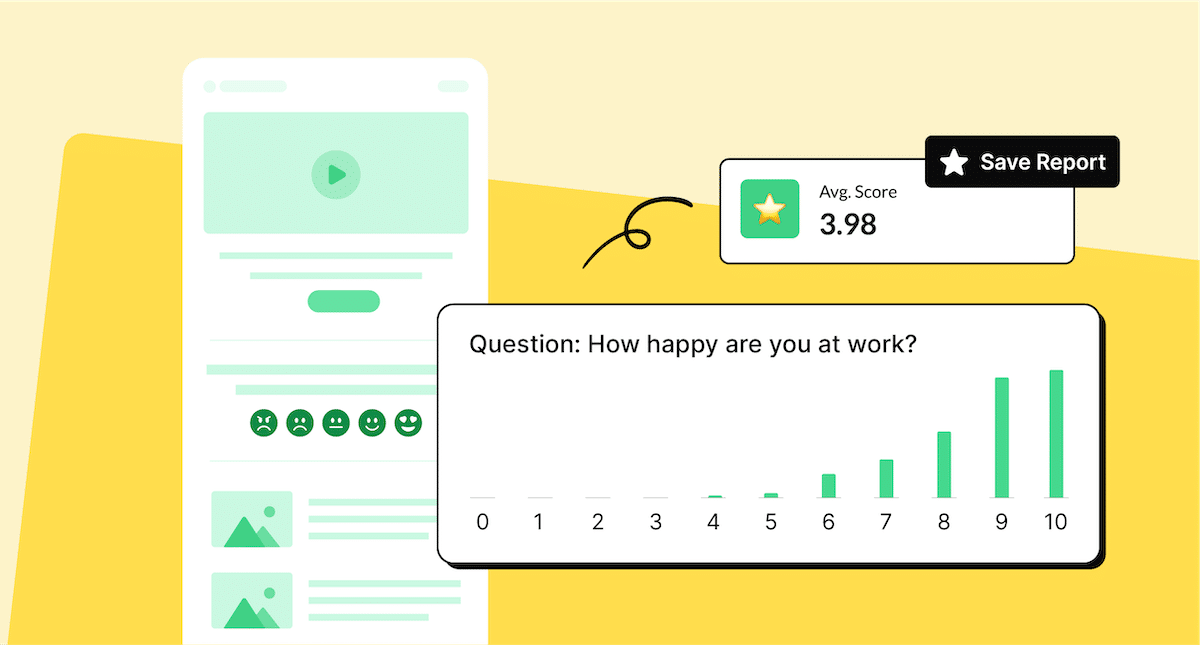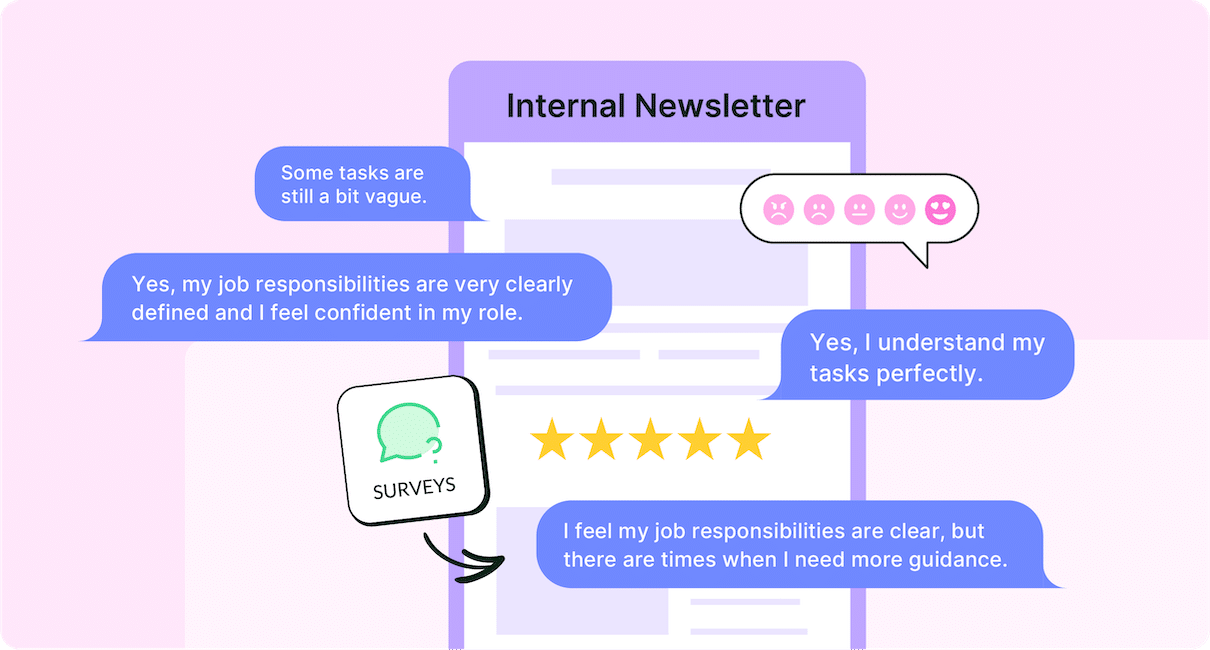Making eNPS (Employee Net Promoter Score) surveys part of your communications strategy allows you to clearly see links between employee satisfaction and workplace retention. In turn, you can make data-driven upgrades to employee engagement.
If you answered ‘yes’ to either of those questions, or the thought of those situations gives you the willies, then keep reading.
Employee engagement and employee retention go hand in hand. Engaged employees are less likely to seek new opportunities, and they contribute to a better workplace culture that is attractive to outside talent.
Want to know what employees really want to see at work? Go straight to the source.
Take a self-guided tour of ContactMonkey
See how our key features can streamline your internal communications.
Take product tour

What is eNPS?
eNPS stands for Employee Net Promoter Score. It measures how likely your employees are to recommend your product/service or your business as a place to work to their friends or family.
Employees who recommend your product or business to their friends and family care about their work and are proud of their workplace. eNPS is a crucial metric for businesses—and essential employee engagement best practice—because it helps you identify if you’re excelling or struggling with employee engagement.
What Does eNPS Measure?
Your eNPS score measures the difference between your happiest and least happy employees. In this way, Employee Net Promoter score quantifies employee engagement and satisfaction across your organization.
The best way to measure your employee NPS is to use an internal communications tool with embedded eNPS surveys. ContactMonkey’s internal communications software lets you do just that. Using the drag-and-drop menu in your ContactMonkey internal email builder, you’ll be able to add employee NPS surveys directly into any email template.
All you have to do next is import your template into Gmail or Outlook and send it off just as you would any other employee newsletter. It’s that easy.
Pro tip: Maximize ENPS survey results with multilingual employee email features by ContactMonkey. If more staff understand the questions, then you will have better quality data to take action on.
Why Does eNPS Matter?
Now that you know what eNPS is and what is measures, why should you care about it?
Your Employee Net Promoter Score (eNPS) survey standardizes the measurement of employee advocacy for a company, brand, or product. It also removes the need for a lengthy employee satisfaction survey.
eNPS surveys have become commonplace in organizations. They help you understand how to adhere to employee engagement models. With this data, both leadership and internal communications teams have a clear picture of improvements and decreases as they happen.
These groups will also be able to:
- Measure employee satisfaction in relation to employee experience
- Be proactive in dealing with workplace dissatisfaction
- Boost your brand as a desirable employer
- Understand eNPS benchmarks to see whether they’re making improvements in the future
Create and send employee surveys for feedback
Engage staff with pulse surveys, eNPS surveys, reusable surveys, custom polls, and more. Ready to send modern emails?
Explore survey features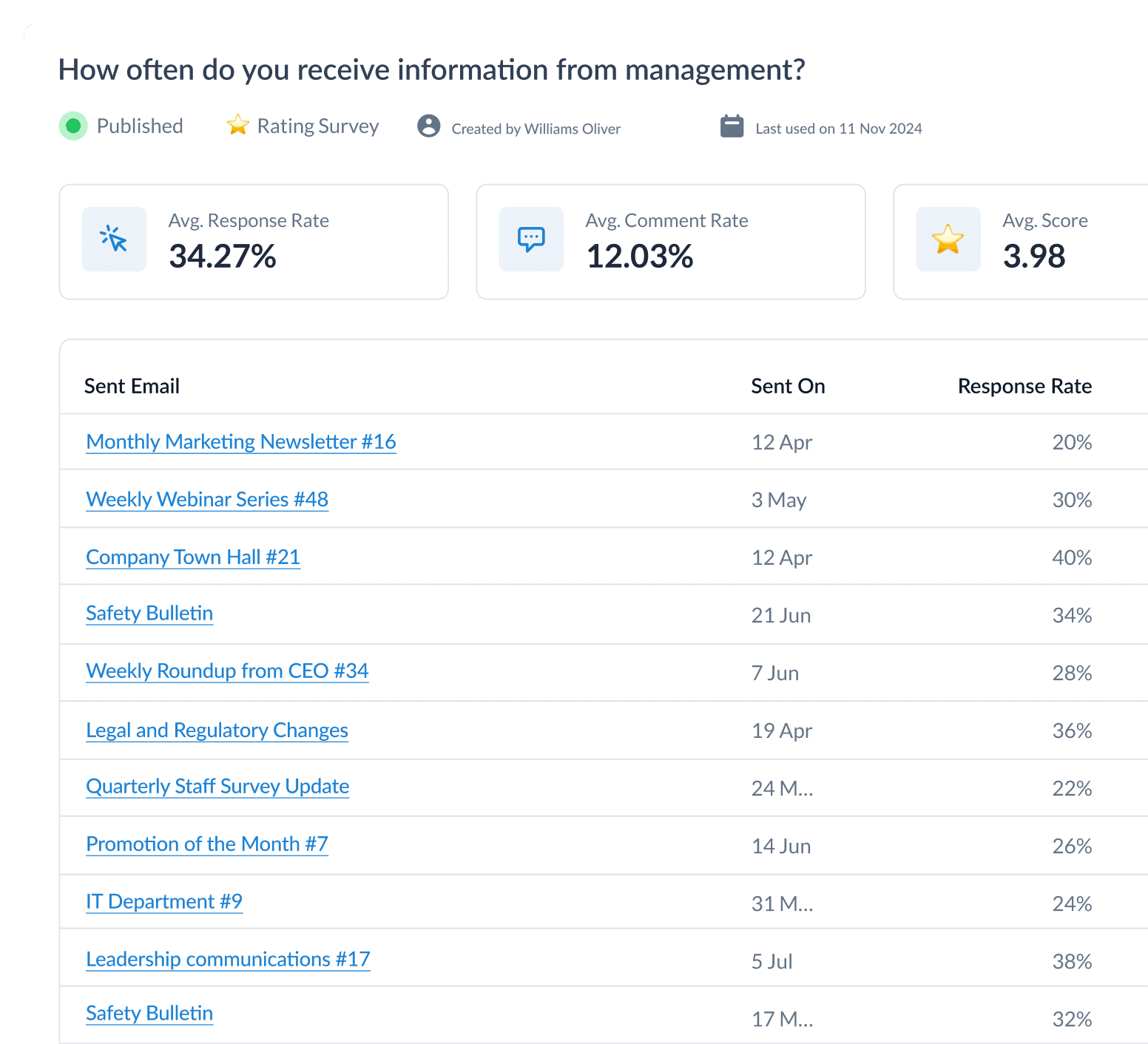
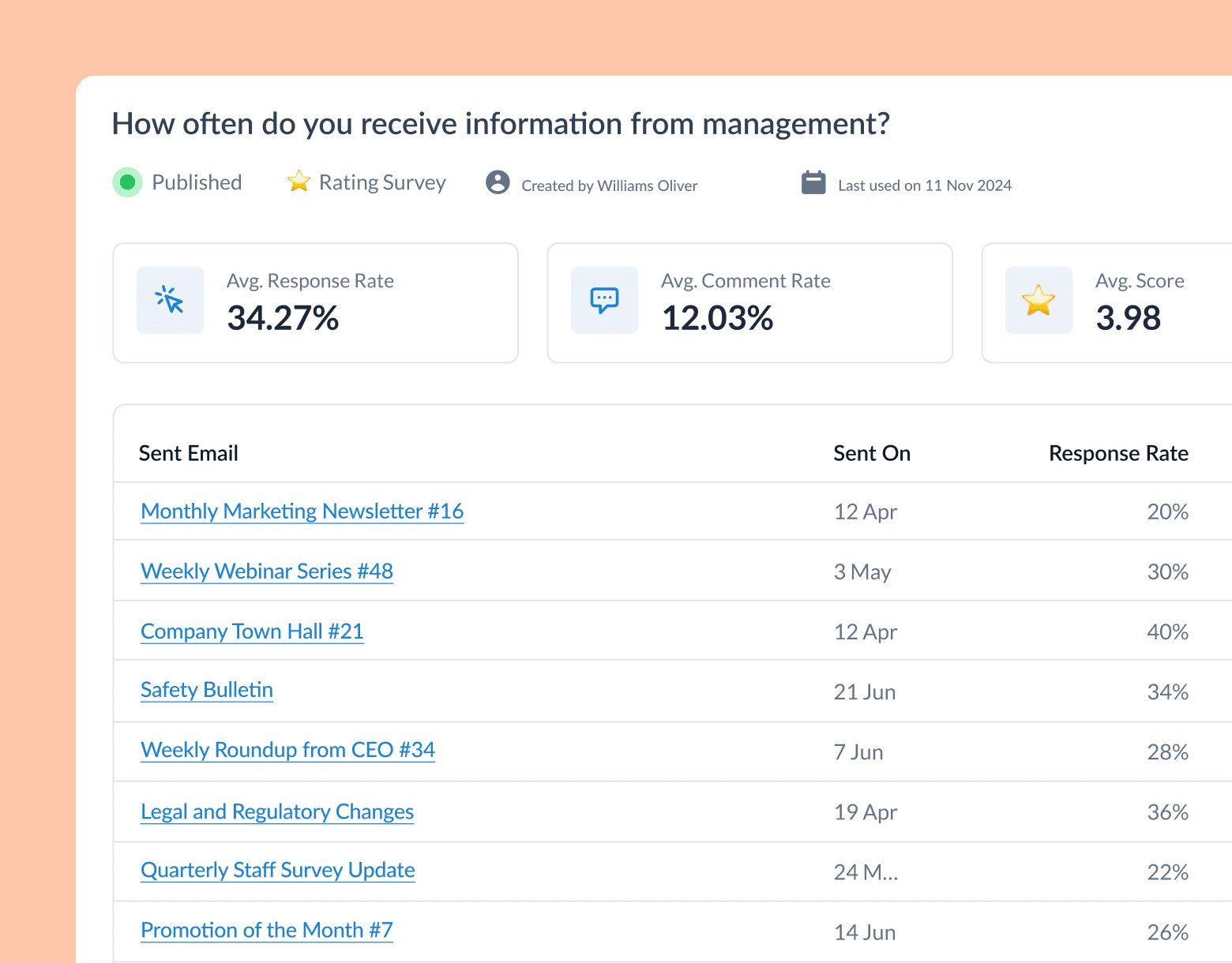
The key: Don’t rush employees. Give them at least a week to submit their responses. They can be weighing a great deal when selecting their rating. Give them ample time to answer; this shows greater concern for individual contributors than the organization.
Collected and interpreted your survey data. If you’re satisfied with your current eNPS, you could use the focus group to distill why certain aspects of the company culture are having such a positive impact within your organization.
Your Employee Net Promoter Score can leave you with a great deal of room for improvement. Use the focus group to show non-members the commitment to improving company culture.
What is an eNPS Survey?
An eNPS survey is focused around a single question, such as: how likely are you to recommend our company to friends as a place to work? Your eNPS survey will then collect anonymous employee feedback and you’ll be able to understand which of your employees are brand promoters and which are detractors. You’ll also be able to identify those who are on the fence between the two, also known as ‘passives.’
How to Use eNPS
With an eNPS tool like ContactMonkey, embedding eNPS surveys into your employee emails happens with the click of a button. Simply drag and drop your eNPS survey from the selection of survey options in your ContactMonkey email template builder. Then, send your survey straight from your Outlook or Gmail mailbox.
Once employee feedback starts rolling in, you’ll be able to easily access all the results in your analytics dashboard. Results will be broken down by total eNPS, the percentage of employee promoters, passives, and detractors. Once you know how to measure eNPS, you can use this information to create better internal communications, improve your employee recognition ideas, and ultimately reduce turnover.
How to Calculate eNPS
How you calculate eNPS is easy. Simply subtract the number of detractors from the number of promoters on your eNPS scale, and ignore passives.
A score between -10 to +20 is considered normal. Anything between +40 and +50 is considered to be an excellent score.
Unlock Internal Comms Superpowers
Discover why 10,000+ rely on us. See the internal email and employee newsletter platform in action.
Book demo

If you want to calculate the percentage of promoters across your team, divide your eNPS by the total number of respondents and multiply this number by 100.
Your formula should go something like this:
(promoters-detractors)/respondents x 100 = eNPS
What Are the Benefits of eNPS Surveys?
The beauty of an eNPS survey is that it’s quick and straightforward, while still able to deliver valuable insights. Not to mention, eNPS calculation is incredibly simple.
Here’s a quick overview of all the benefits of an eNPS survey:
- Quick to create, simple to measure
- Most employees are familiar with it so there’s no learning curve
- eNPS surveys are proven to have a higher participation rate than other surveys due to its simplicity
- Employee Net Promoter Score surveys are a cost-effective solution
- eNPS metrics are clear and straightforward to work with when acting on results
How To Measure eNPS
The overarching reason behind eNPS is for teams and their leaders to bring issues to the surface. They can also create a system for prioritizing and improving upon these issues.
This type of employee pulse survey is one piece of a puzzle that supports team leaders in:
- Coaching themselves and their team members
- Taking action on trending organizational issues
- Being viewed as a support system for workers
The outcome of eNPS puts emphasis on sharing anonymous employee feedback quickly and completely with leadership teams. They provide more clarity on what elements of employee sentiments and engagement directly affect customer loyalty and satisfaction.
eNPS is embraced by organizations because of how simple it is to conduct. The survey itself doesn’t take a lot of effort to create, and the data is easy to interpret.
Create internal emails that get opened and read
No design or technical expertise needed. Save time, increase engagement, and dazzle your employees with fun and interactive communications.
Explore email features

If you wish to target only a portion of your workforce for your eNPS survey, consider using a custom email list to reduce the number of irrelevant emails your employees. Using ContactMonkey’s List Management feature, you can create your own custom email lists—without IT—to better target your employee surveys. Custom email lists built with ContactMonkey integrate with your Human Resource Information System (HRIS) like Workday and ADP, as well as Azure Active Directory, so they’ll automatically update.
eNPS Survey Examples
eNPS surveys typically consist of only one question. But secondary follow-up eNPS questions can help internal communicators to glean more information on underlying company issues. The most frequently asked question for eNPS goes a bit like this:
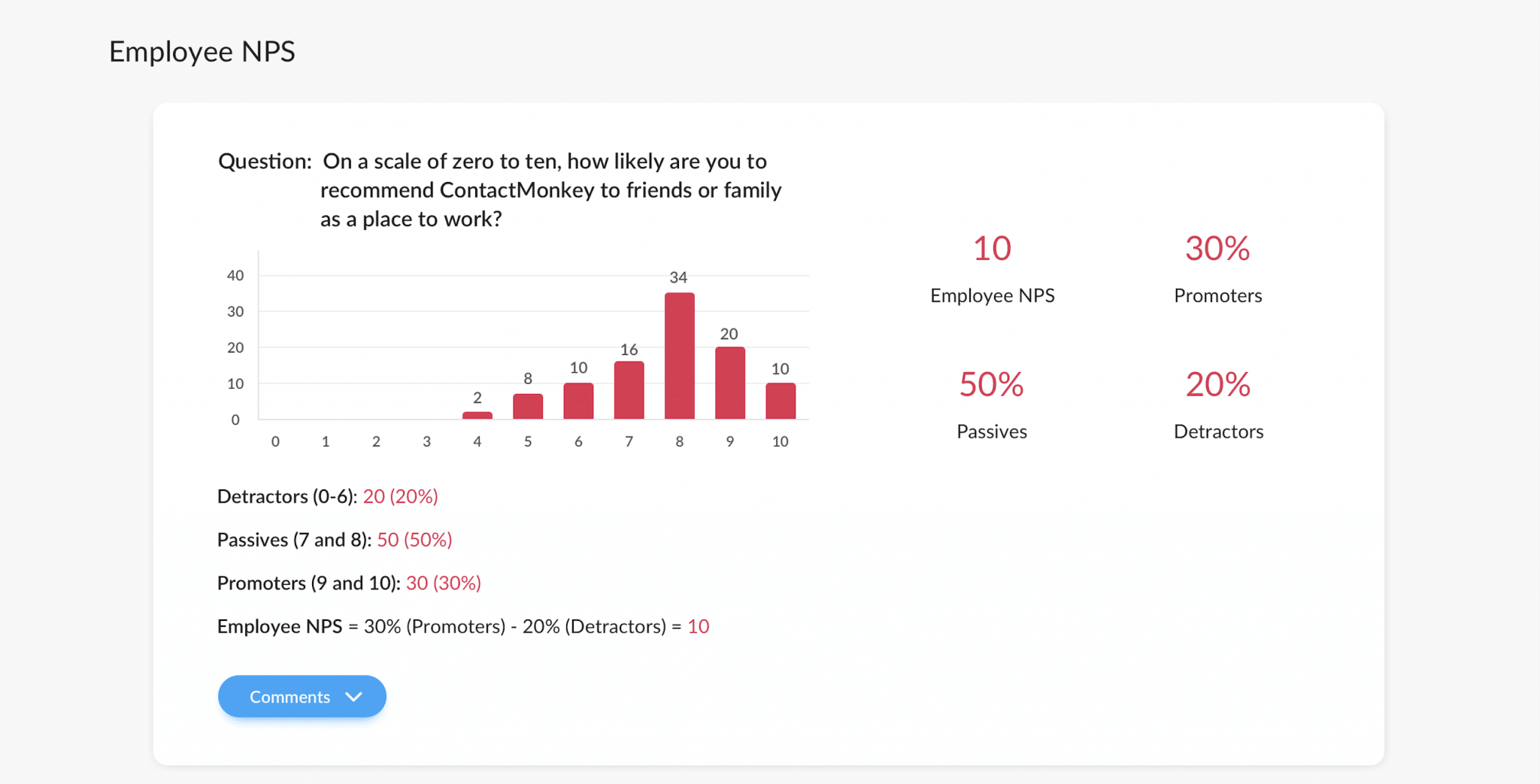
Internal communicators are trying to understand how employees feel about working at the company. If they want to learn how employees feel about the product, they may want to ask something like:
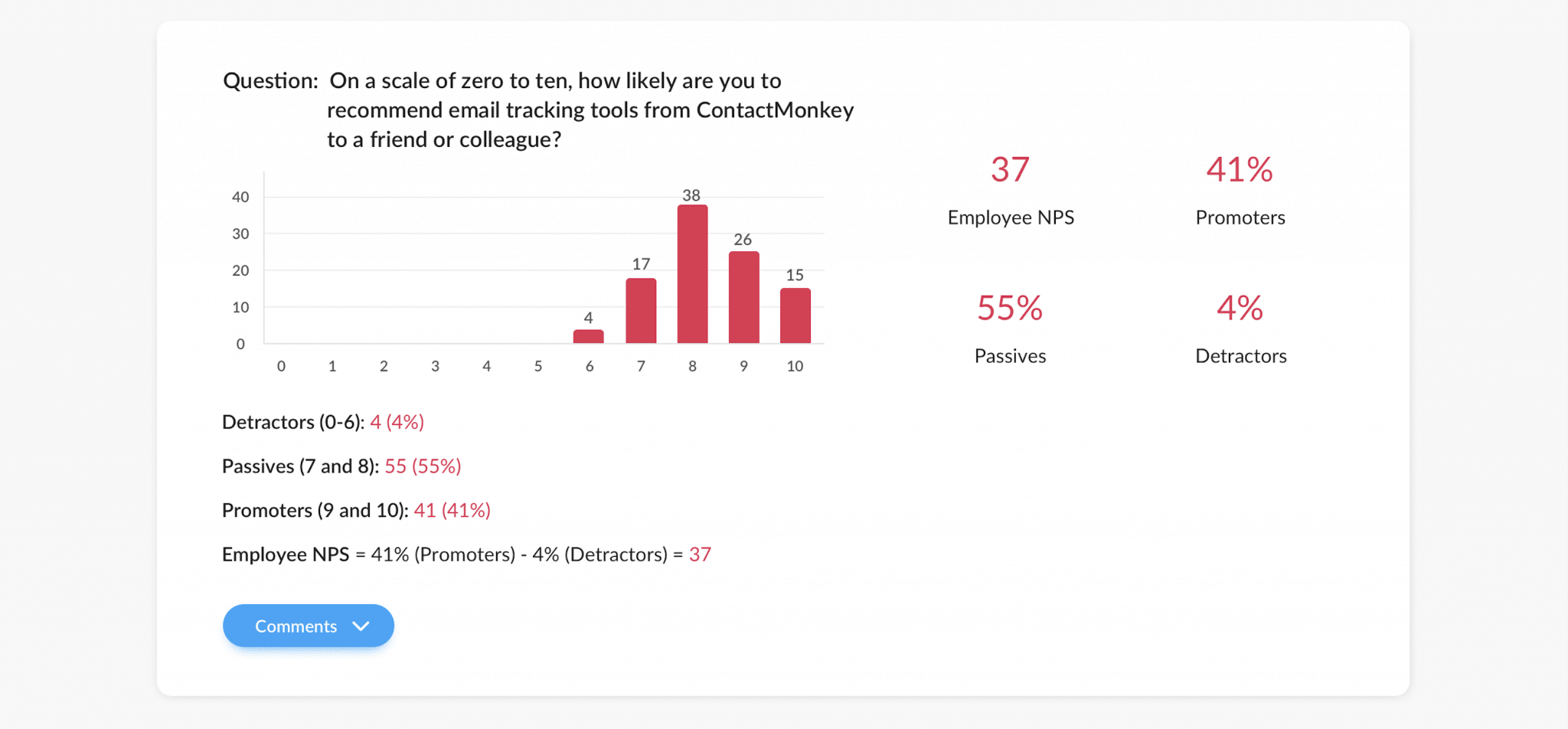
Asking this second question is a great way to segment reviews around different areas of the business. Employees might not enjoy working for the company or their particular role. But they may feel that the product or service the company offers is heading in a positive direction.


eNPS score range
Overall, eNPS ranges from -100 to +100. Something between -10 to +20 is considered to be a normal score, and between +40 and +50 is considered to be an excellent eNPS. Below is one of the most common eNPS survey examples.
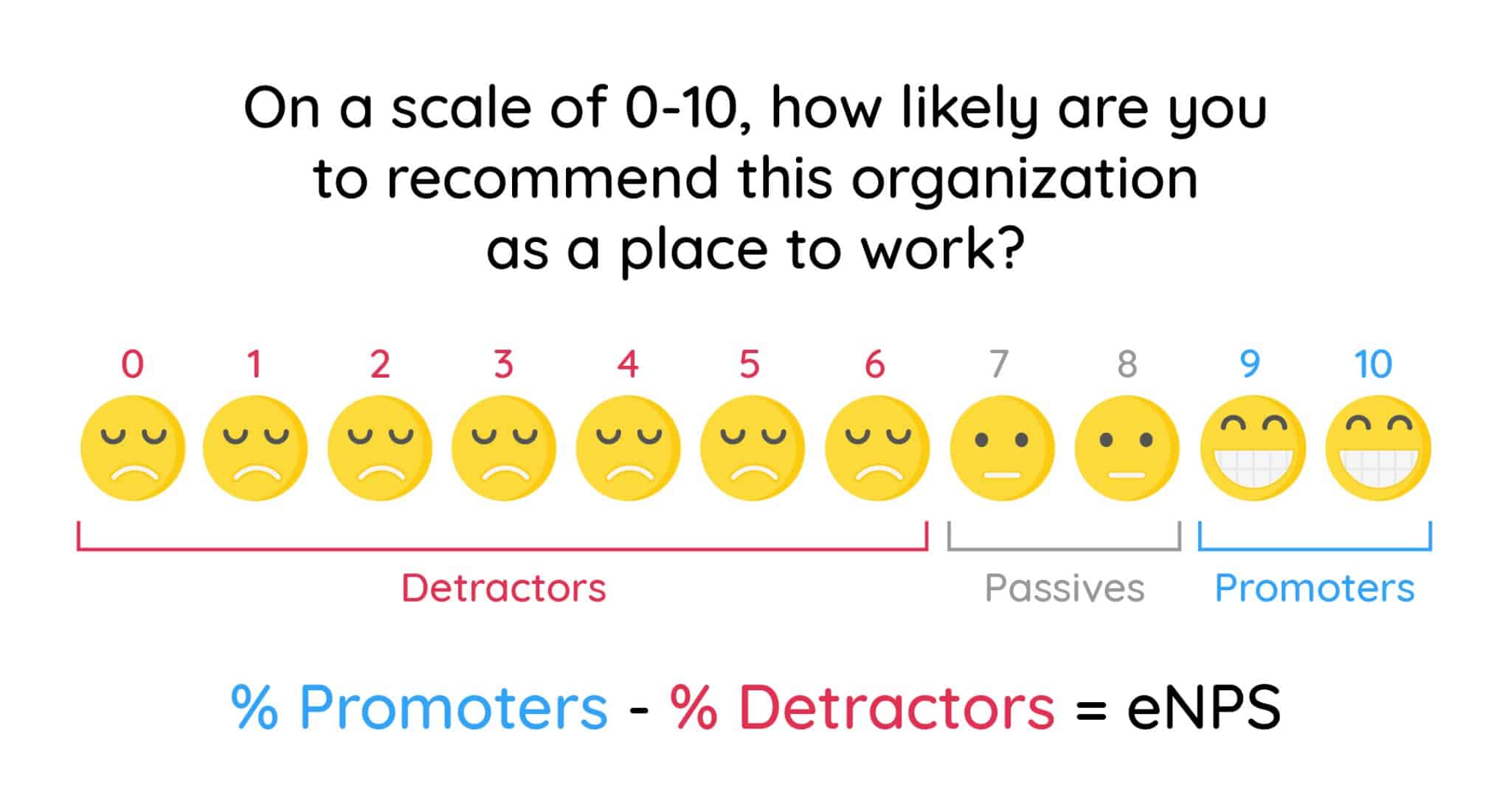
A word of caution…
One of the main shortcomings with eNPS is that it favours a larger sample size. Though a setback for smaller companies, larger companies can really benefit from measuring eNPS.
Another issue is that eNPS is very much grounded in numerical data. It does not present a way to quantify human emotions. Instead, it just provides HR and internal communications professionals with a standard to hold their organization to.
Often, extra research or comparisons with other companies are needed to better understand where your company sits. This added work makes it harder for internal communicators to share the results with employees, causing action to be delayed.
Why Should Organizations Measure Engagement
Organizations should consider measuring eNPS because it provides a clear metric around employee loyalty. eNPS examines whether or not an employee is satisfied in their role or with the organization. It shows why employee engagement is important. It also examines whether employees would be willing to speak positively about your product or service in a positive manner.
If you’re looking for a way to ease into measuring employee engagement, it’s an easy way to get started. Consider these three aspects of loyal employees:
- Caring more about the company and usually work harder
- More invested in your business, and are more likely to stay longer
- Constantly looking for ways to improve the organization as a whole
Start two-way conversations and employee feedback loops
Learn how to engage staff with pulse surveys, content ratings and reactions, custom polls, and more. Ready to send modern emails?
See engagement features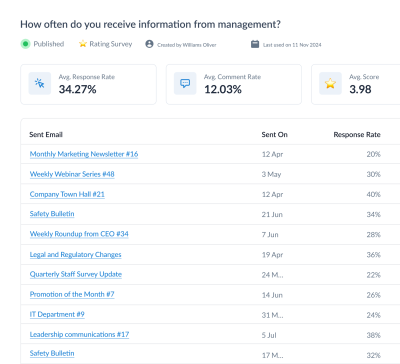

You want to know that you have more loyal employees (i.e. promoters) than unhappy or disloyal employees (i.e. detractors). The numbers around employee engagement and retention show that:
- Replacing an employee costs companies about 20% of the departing employee’s salary.
- There are costs associated with hiring, training, lost productivity, and mistakes.
- It takes up to three months for a new employee to be in the value-add stage.
- 59% of employees wouldn’t recommend their company as a good place to work.
With more people statistically unhappy at work than not, organizations can’t afford to put internal communications at a low point on their list of priorities. Keep employees in the loop so they’ll be invested in what you’re offering and what they’re doing.
What is a Good Employee Net Promoter Score?
The short (and unsatisfying) answer: it depends. The size of your company, what your company does, your company culture, and other factors all influence what you can expect in terms of eNPS. We recommend using our Internal Benchmark Report 2025 to determine what is a good employee net promoter score for companies in your sector.
It’s most common for HR and internal communications departments to deploy an eNPS survey on a quarterly basis. It’s not too seldom nor too frequent, which leads to improved survey response rates from employees. The higher your eNPS, the more employee-centric your organization is.
This is exactly why we at ContactMonkey take increasing employee engagement so seriously. Employees are the lifeblood of your business, and measuring your eNPS against your industry’s employee not promoter score benchmark is like taking your blood pressure. ContactMonkey’s employee engagement and eNPS software—like pulse surveys, emoji reactions, and anonymous comments—make it easy to learn how your employees really feel and compare your results against eNPS benchmarks by industry.
Tips for Conducting an eNPS Survey
How you deliver your eNPS survey will determine the quality of its results. It will also impact the likelihood of employees taking the time to respond. With that in mind, it’s important to pay attention to some of these eNPS survey best practices when rolling out your survey:
- Streamline your survey: Make sure your survey is streamlined with the rest of your internal communications.
- Maximize engagement: Drill down the best time to send internal emails to ensure the highest possible open rate.
- Gather the details: Add an anonymous comments box so employees can elaborate on their responses.
- Take action on your feedback: Employees will only be motivated to continue giving feedback if it drives change.
How to Analyze Your eNPS Feedback
If you’re looking to improve on your eNPS, it’s important to look at feedback from all groups. Even though promoters and detractors are the only ones considered in the final score, passives are still representative of active employees. Therefore, it’s a great idea to get their opinion as they’re neither happy nor unhappy at work, and can be more neutral with their feedback.
Interpreting promoter feedback
Promoters are the happiest employees in your organization. Take the opportunity to ask them what it is that they love so much about where they work. This will help you better understand the areas of the company that are successful.
Making an effort to know what’s working well can be useful to HR teams in both recruiting and retaining talent. These are initiatives and practices that you can double down on, and ensure to highlight when you’re onboarding new employees. Your approach to your employee onboarding is crucial in starting new employees on the right foot.
Interpreting detractor feedback
Overall, these employees are unhappy at work. Although it’s expected that their feedback will be mostly negative, the best way to uncover what their biggest issues are is by asking them to share what they really think in a safe space.
Once you have all of that information on hand, show them that their concerns are being heard by taking action. By doing this, you can improve their negative perceptions of the company culture around transparency and active listening, and perhaps deter them from leaving the organization.
Interpreting passive feedback
Remember: These employees represent the population of employees that are generally satisfied at the organization. Similar to how you should handle detractors, when it comes to understanding their rating, ask them for feedback around what holds them back from giving a ranking in line with promoting the company.
Once you gather this feedback, it’s your responsibility to work hard to convert passives into promoters. Make it safe for them to be completely open and candid with their feedback. Be ready to take action so that they have evidence that they are being listened to.
Take a self-guided tour of ContactMonkey
See how our key features can streamline your internal communications.
Take product tour

How to improve your Employee Net Promoter Score (eNPS)
How can you improve eNPS? Employee engagement is a complex metric that encompasses numerous factors and influences, which makes deciding how to improve eNPS a somewhat tricky question.
In addition to carefully refining your employee engagement strategy and measuring your results against your industry’s net promoter score benchmarks, here are some actionable ways your can improve your eNPS:
- Share results with leadership and individual contributors
- Make an action plan for positive organizational change
- Communicate the full cycle of the employee survey results
- Filter data to better understand what priorities should be
Keep the lines of communication open, and be prepared to discuss the results and answer eNPS survey questions from all levels. All these employee net promoter score tips should help understand how to improve eNPS and get more accurate eNPS calculations.
Measure eNPS with ContactMonkey
Using ContactMonkey’s eNPS survey software, you can easily add eNPS survey questions to your internal emails. To embed a survey, all you have to do is select an eNPS survey from the template builder sidebar and drag it to your desired location within the newsletter with ContactMonkey’s eNPS tool:
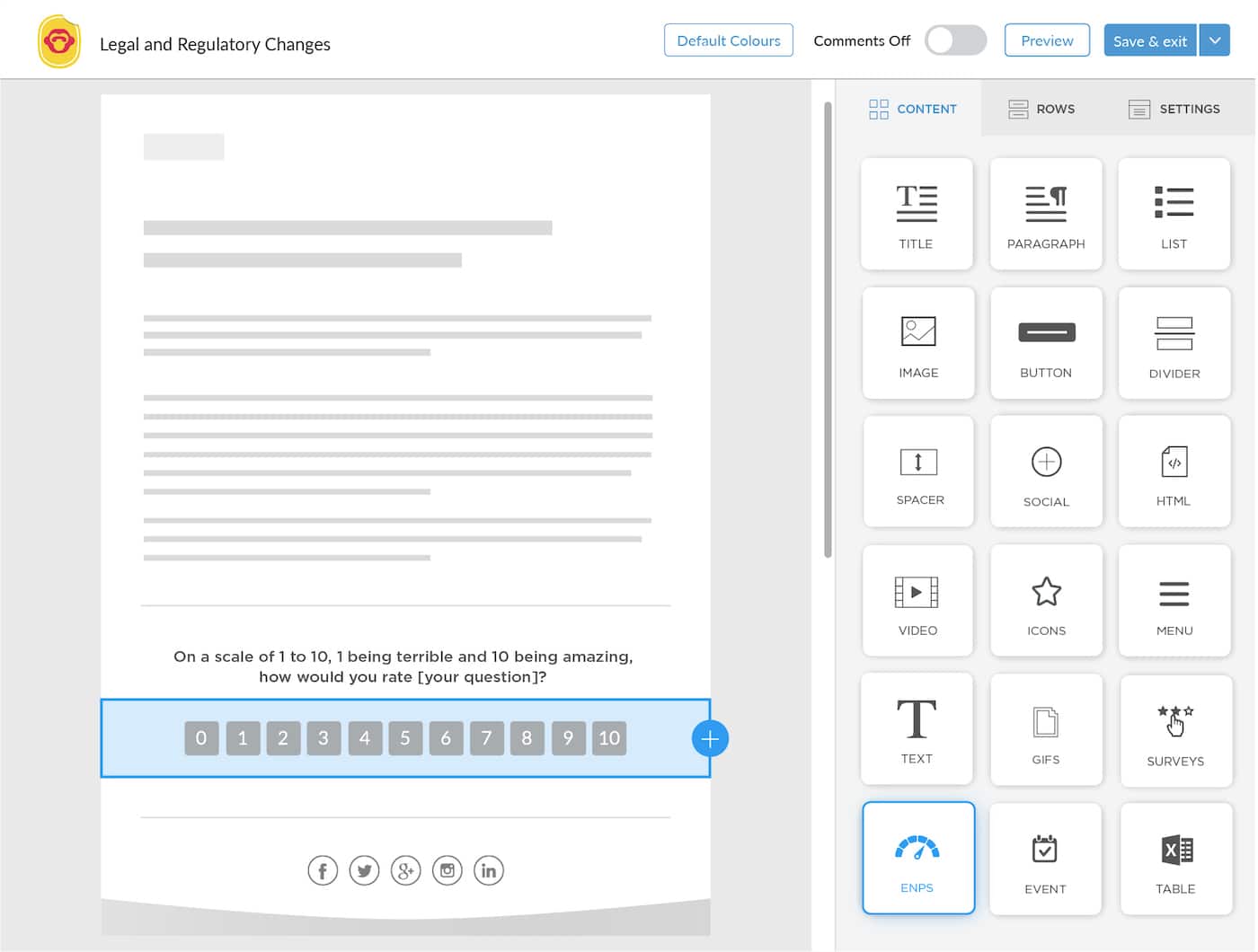
Employees just have to make their selection on an eNPS scale from 1-10, and since you can track emails in Outlook and Gmail, the results are compiled and displayed on ContactMonkey’s Campaign Analytics page.
Find Your Most Engaged Employees with eNPS
Are you ready to start collecting feedback from emails? With ContactMonkey’s internal email tracking tool, you can easily feature your employee newsletters ideas while gathering real-time analytics. Book your free demo today.
